A Leading Sub-GHz Wireless Mesh Network in a Module
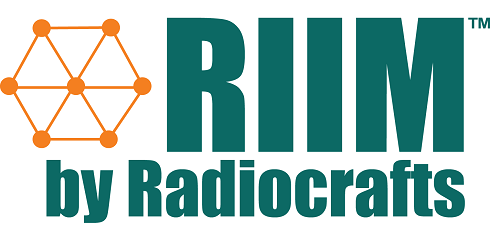
Developed as a long range, ultra-low power, highly reliable Mesh Network For Control Applications!
RIIM (Radiocrafts Industrial IP Mesh) is an embedded RF system designed to be an all-inclusive, easy-to-use, long range, low power, Sub-GHz wireless mesh network providing unmatched reliability in data transmission success rates and scalability. The RF protocol is the IEEE802.15.4 g/e standard. In addition, RIIM includes an Intelligent C-programmable I/O (ICI), which makes it possible to directly interface to any sensor or actuator and pre-process sensor data. RIIM does not require any license or subscription fee.
Radiocrafts’ commitment to making wireless connectivity easy for network designers working across a variety of radio frequency networks was the driving motivation for developing RIIM additions to the IEEE802.15.4 g/e standard.
The RIIM system consists of the following parts:
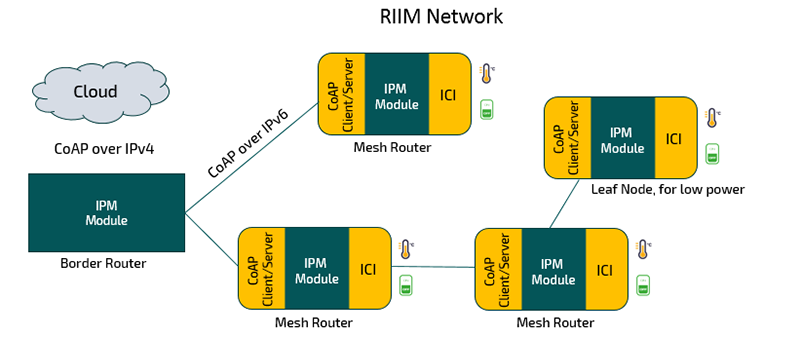
RIIM offers numerous benefits for a wide range of applications including but not limited to:
- Emergency Lighting
- EV Charger Communication
- Smart Irrigation
- Smart Street Lighting
- Solar Applications
- And other wireless sensor networks

Short Development Time – Everything is included in the module
RIIM is based on the IPM module, fully RF tested during production. It includes all the critical components for a complete Sub-GHz wireless mesh network. As a result, RIIM is ready to go out-of-the-box when you get the module without the need to pay license or subscription fees.
Read more about node commissioning in RIIM in the application note below!

Long Range and Massive Coverage
RIIM is based on the IEEE802.15.4g/e standard which is a robust long range network ideal for most industrial applications.
We have measured the range between RIIM network devices and have summarized the results in the table below:
Range LOS | Range Urban Environment | Range Semi Open Rural Environment | |
RC1882CEF-IPM Module | 5 km | 200 m | 400 m |
RC18x2HPCF-IPM Module | 20 km | 700 m | 1400 m |
Read about RIIM range tests performed by Radiocrafts in our Application Note below!
A RIIM data packet can be forwarded across the network by hopping from device to device up to 28 times (28 mesh hops). To illustrate, 28 mesh hops combined with 2-way symmetric communication means that a RIIM Sub-GHz wireless mesh network can cover an area of up to 40 km x 40 km squared for the high-power module and an area of 12 km x 12 km squared for the regular module in an urban environment. In a similar manner, in a semi-open rural environment the range is approximately twice that of an urban environment.
The RIIM Mesh Router, responsible for forwarding data packets through the networks, can handle down to 35uA @ 3.3v average power consumption enabling all battery operated devices in the network to further extend the network coverage. 20uA in 150 kbps mode.
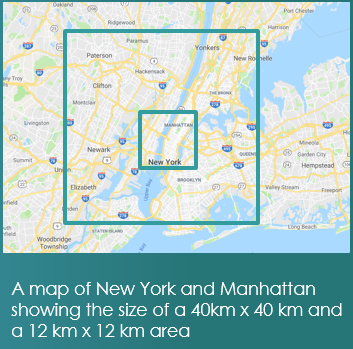

Unmatched Reliability in Data Transmission Success Rates

We have added a new PHY/MAC layer to RIIM which is a frequency hopping mode called TSCH (Time-Synchronized Channel Hopping).
In brief, frequency hopping omits challenges with narrowband interference. Data transmissions are done at several frequencies and at different time slots in a synchronized schedule. A packet lost between two devices will be re-sent on a different channel in next available time slot. So, if you have narrow noise, this will increase the probability of a successful retransmission and thus reduce packet loss seen from the application.
TSCH was designed to make a Sub-GHz wireless mesh network with less packet collisions and higher reliability. As a matter of fact, A TSCH network has proven to have a reliability of 99.99%.
In addition to TSCH, RIIM uses a new technology feature from Radiocrafts called Distinct Channel Hopping which is designed to make a wireless mesh network with significantly less packet collisions and overlapping data in an area where several RIIM mesh network are operating in close proximity. Distinct Frequency Hopping allows you to send data packets from several different RIIM networks at the time slot but at different frequencies (on different channels) creating a collective system where the data packets never overlap, reducing the possibility of packet collisions significantly. Even over several time slots, the messages never overlap, creating an ultra-reliable network including in environments where several RIIM networks are operating at the same time.

With TCSH setup for 50 channels, the system fulfills the FCC requirement for frequency hopping outlined in §15.247. As a result, this enables RIIM devices to send up to 1W output power and thereby creating a Sub-GHz wireless mesh network with huge coverage.
Additionally, TSCH enables battery operated mesh routers. The radios can be shut down in a period where there is no packet to send and no incoming packet expected.

High-Throughput Networking for High Data Requirements
Radiocrafts has implemented a new ground-breaking feature in RIIM called Adaptive Frequency Agility (AFA). AFA allows for high-throughput networking by taking the allowed duty cycle in Europe from 1% to around 40%!
To illustrate, you can now go from 1 packet reaching the Border Router every 4 seconds to 40 packets every 4 seconds!
RIIM uses a combination of Channel Hopping, Listen-Before-Talk and Adaptive Frequency Agility to achieve this.
Listen-Before-Talk is a technique where the radio scans the channel assigned to it by the TSCH algorithm before transmitting on it. At this point, if the channel is found to be noisy, the radio waits and does not transmit on it. Therefore, dramatically increasing the radio’s resilience to noise.
Adaptive Frequency Agility works by scanning and marking all channels which are often found to be noisy. Subsequently, those channels are dropped from the frequency hopping list. This ensures that the radio only transmits data using the best channels with the least noise.
In addition, the Border Router can now listen for incoming packets all the time, thereby increasing the maximum throughput into the Border Router up to 20 times depending on the which TSCH mode is used.
Furthermore, RIIM supports a 150 kbps mode which supports applications with a higher data capacity requirement.
Read more about this in our application note below.

Ultra-Low Power For Battery Operated Devices
Low current TX/Rx/Sleep
- TX 26 mA@ 14 dBm
- RX 6.2 mA
- Idle 4.7uA average
RIIM is also ultra-low power for battery operation supporting long lasting projects.
RIIM has a number of features that reduce power consumption enabling more than 15 years battery lifetime on 2 AA batteries. These include:
- The chosen electronic components inside are low power to start with.
- Network end devices can be put in “Sleepy” mode, reducing the current consumption to 4.7 uA. In deep sleep mode, the power is reduced even further to 2.8 uA.
- The output power of the module is configurable, not to consume more power than needed during transmit.
- RIIM devices can sleep when there is no time slot for incoming or outgoing RF data packages.
- RIIM devices can handle down to 35uA @ 3.3v average power consumption enabling all battery devices in the network to further extend the network coverage. 20 uA in 150 kbps mode.
- The data processing that can be done by the customer in ICI can save substantial power. The RIIM Sub-GHz wireless mesh network supports cloud computing which means instead of sending all raw sensor reading data to the Cloud, the user can just send the interesting data, such as an alarm when a threshold is met.
Read more about the low power capabilities in RIIM from our Application Note below!

Interface To Any Sensor Or Controller
Radiocrafts’ ICI Framework allows the user to access hardware interfaces and manipulate data on the module before sending it onwards. As a result, any sensor/control unit can be interfaced to directly to the IPM module. Another major benefit is that the sensor interfaces can be updated in the field using Over-the-Air (OTA) updates, creating a future proof solution with room for new or updated sensors/control units.
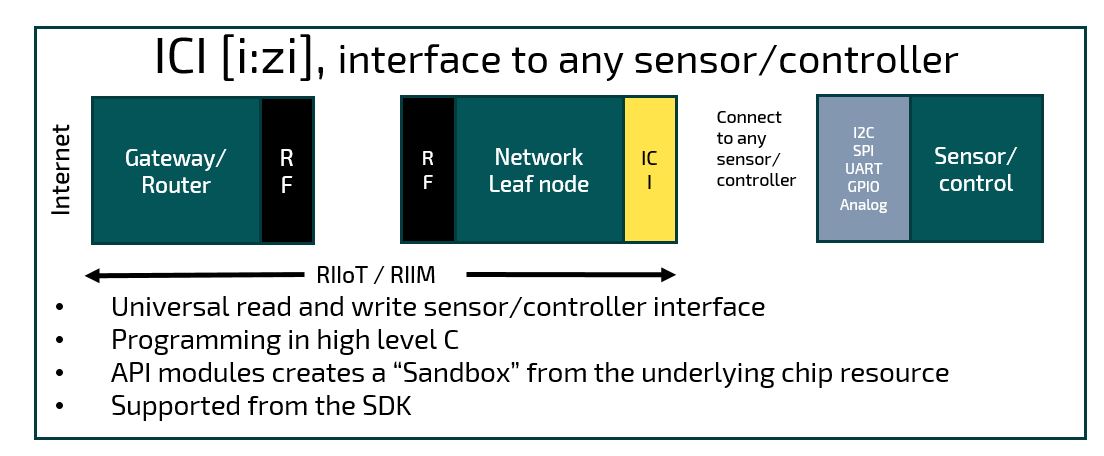
Learn more about ICI here.
Visit Radiocrafts’ GitHub page to explore sample codes for Radiocrafts’ ICI applications.

Future-proof with Over-the-Air updates
Your product will be future-proofed by RIIM’s Over-The-Air (OTA) Updates capbilities. OTA updates are possible because of RIIM’s two-way communication channel and the module’s internal flash memory.
Consequently, you can upgrade RIIM devices in the field when the Sub-GHz wireless mesh network is already deployed/fully operational by upgrading their ICI applications. In other words, you can create new sensor/actuator interfaces, new signal processing algorithms, and updated security patches. Furthermore, you can keep the underlying RF system firmware current using RIIM Over-the-Air updates.

Global Support – FCC/CE Certified – 865/ 868 / 915 MHz
RIIM is compliant to EN 300 220, the 868 MHz band in Europe, is pre-certified for FCC CFR47 Part 15.249, the 915 MHz band in the Americas, and supports a frequency hopping mode on 20 channels which are used in the 915 -928 MHz band intended for use in Australia/New Zealand. Moreover, RIIM supports one frequency hopping band for Vietnam at 918.8-921.8 MHz (hopping on 16 channels) and India at 865-867 MHz (hopping on 9 channels).
In fact, The RIIM module is software configurable and the remaining hardware can typically cover both 868 MHz and 915 MHz.
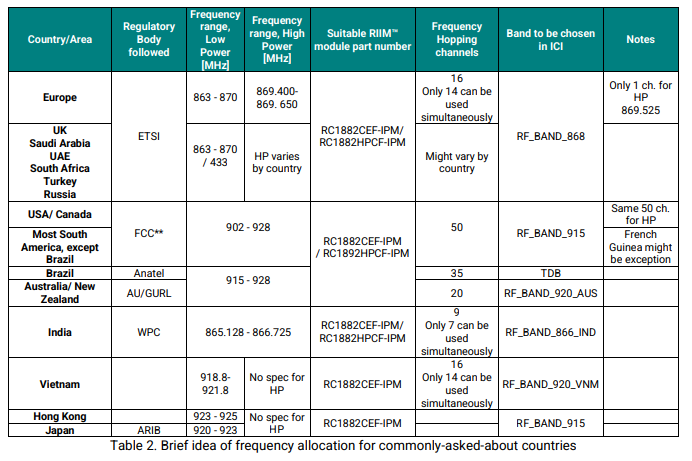
The 915 MHz frequency band is allowed in most of North and Latin America, and half of South America. Brazil, for example, follows other regulations. However, those regulations are technically possible to support with RIIM, but are not implemented in the standard offering. Contact Radiocrafts for support. The 868 MHz is allowed in Europe and many countries in Asia and Africa.

Network-Wide and Local Multicast For Remote Management
With multicast you can optimize your remote configuration management by enabling software updates Over-The-Air and mass distribution of messages to all devices in the network at once to reduce on-air communication time. Consequently, this eases situations where you want to send the same message to several devices at once. This is also useful if you want to update a parameter in the whole network at once.
Additionally, in massive networks, multicast enables you to create dynamic groups of devices. In general, it allows you to update a certain parameter for specific device groups all at the same time. For example, turning on/off streetlights in a specific area of the city, adjusting the colour of the lights, adjusting the dimness, and more. This makes maintenance and management of the Sub-GHz wireless mesh network much simpler.
Multicast also offers stronger resistance to noise interference. That is, since messages are propagated simultaneously along multiple paths, the messages should be able to reach their recipients even if several paths in the network break.
Meanwhile, one-hop multicast or local multicast is similar to network wide multicast except a device only sends data to it’s neighbor devices without flooding the entire Sub-GHz wireless mesh network with packets. This is important in, for instance, streetlighting, where one light pole wants to share some data with the nearby light poles.

Automatic Network Set-up – Self-forming/Self-healing
A key benefit of a mesh network is the ability to self-form and self-heal.
To clarify, the network identifies the devices that share the same network ID and automatically creates a network structure that connects all devices to the border router. Another key point is that this process is fully automatic, the user does not manage this process. Subsequently, once the network is established, the connectivity is constantly monitored for changes. If a device disappears or a new device appears, then the network will re-route itself to accommodate the change. Similarly, this process also takes place without user interactions; it is fully automatic.
Monitor the quality of the links via the RIIM Network Dashboard.

High Node Count
The RIIM Sub-GHz wireless mesh network is designed for large device counts with it’s short transmit pulses and TSCH (time synchronized channel hopping). This minimizes packet collisions which is the largest problem for high device count networks. As a result, a RIIM network will support up to one thousand devices.

CoAP(s) Interface To The Cloud
CoAP is supported in the RIIM IPM module providing simplified integration with the web to make RIIM internet ready.
To explain, each network node has an IP address and a CoAP client/server which means you can get direct addressing to and from the cloud application.
Additionally, the RIIM Sub-GHz wireless mesh network has a low complexity border router. This means that unlike a gateway, you do not need to do data reconfiguration or address translations.
Moreover, a border router is much cheaper than a gateway.
CoAPs also includes DTLS end to end security.
Furthermore, low overhead and simplicity are key features of CoAP, developed to support Internet of Things (IoT) and Machine-to-Machine(M2M) devices.
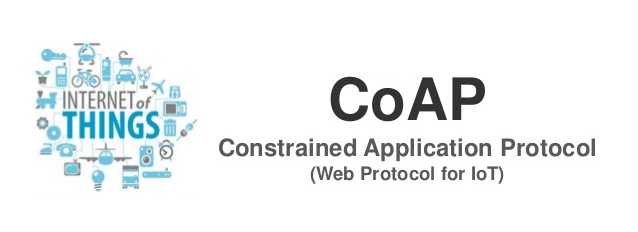
RIIM is designed to have direct cloud connection using protocols such as IPv6, UDP, CoAP and DTLS. Evidently, this eliminates the need for a dedicated gateway and offers direct end-to-end IP packet communication with end-to-end security. In addition, RIIM can operate in a local mode where no internet connection is used.
A third use case that is common is to extend RIIM with an edge gateway which serves as a network entry point for devices talking to cloud services. You can then have an external cloud connection from the gateway device. For example, this is useful when the user intends to implement some edge-computational functions, thus decreasing latency and in case connection to the cloud is lost.
Read more about connecting RIIM with an edge gateway in our application notes below
Also visit Radiocrafts’ GitHub page for a sample code on how to connect a RIIM network to an edge computer.

Direct IP Communication
The RIIM Sub-GHz wireless mesh network uses 6LoWPAN packets in the RF network to enable IPv6 communication to each individual sensor/controller. In addition, the border router provides IPv4 to IPv6 transition to communicate on IPv4 to the outside world. This makes RIIM directly compatible and accessible to most cloud services.
Additionally, we have added SLIP to the Border Router which enables IPv6 packets over UART to an external processor. This is typically a Linux based system where routing rules and packet forwarding can easily be set up.
Read more about this in our application note below.
Visit Radiocrafts’ GitHub page for a sample code on how to connect an edge computer to a RIIM network.

Time Synchronous Events
All devices in the network are synchronized in time with < 1ms accuracy. A new API has been created to allow users to make synchronous events based on the timing.
What are the benefits of time-synchronization?
- A common understanding of time in the RIIM Sub-GHz wireless mesh network.
When all devices are aware of time, synchronizing events becomes possible. Take the case of a street lighting application, where the operator can automatically turn all streetlights on at 17:00 at the exact same time, then off again at 07:00.
- Awareness of each devices’ time in relation to others.
For example, you can now turn on a certain group of light bulbs as soon as another group is dimmed.
- Timestamping of certain events.
For example, a certain sensor reading can be time stamped by adding the real time information into the sensor reading packet. This way, important events can be tied to certain times, to allow for better data analytics.
Read more about Time-Synchronization in our application note below!

Industrial Grade Quality
Since the foundation of Radiocrafts, we have been focused on industrial applications with high quality. Examples of proven solutions in RIIM are:
The performance is also adapted to meet the strict reliability standards of industrial applications. For instance, frequency hopping with TSCH helps to find the noiseless channels and the 700m range in urban environments translates to coverage in large industrial sites with good margins. Additionally, RIIM has support for RS485 meaning the radio module can more easily support protocols such as Modbus.

Advanced Security
RIIM includes low level encryption by default. In other words, your Sub-GHz wireless mesh network is protected by encryption using a pre-shared key. This encryption works on the link layer, and protects against eavesdropping, rouge devices joining an existing network and fake packets.
The pre-shared keys are programmed during installation or production. All devices have the same pre-shared key.

Mist Computing Platform
Mist computing is important as it reduces the required bandwidth in the network. This is important as a typical wireless network device will spend 5x the power on communication vs computing. The compute resource is a low power MCU on the radio chip. The communication power is used by high power amplifiers that need power to operate.
Typical algorithms used in mist computing are.
- Data aggregation
- Pre-conditioning of data
- Filtering
- Pattern recognition
- And many more
Learn more about ICI here.

Tailor Made Solutions Through Radiocrafts’ Design Services
A benefit of working with RIIM and Radiocrafts is that the standard solution can be modified to fit individual customer requirements that are not covered with the standard solution. Radiocrafts has extensive experience in RF design and turnkey solutions across several applications. A special case is if the modifications required can be done in ICI. The effort and costs will be minimal compared to a traditional turn key contract design. Please contact Radiocrafts to discuss the specific case.
DATA SHEETS AND USER MANUALS
File type: |
File name: |
File description: |
|---|---|---|
This is a web-based (Online) Document Library for RIIM, Radiocrafts’ Industrial IP Mesh solution. In this web-based document library you can find an introduction to RIIM, User Manuals, Quick Start Guides, benefits and features of RIIM, technical information on RIIM, an FAQ for RIIM, and much more. |
||
This document covers the relevant information for the RC1882CEF-IPM module. You will find a description of the RIIM™ overview, firmware structure, the ICI programming concept, pin assignment and description, regulatory compliance information, mechanical drawings, PCB layout recommendations, and more. |
||
This document covers the relevant information for the RC18x2HPCF-IPM modules. You will find a description of the RIIM™ overview, firmware structure, the ICI programming concept, pin assignment and description, regulatory compliance information, mechanical drawings, PCB layout recommendations, and more. |
||
The User Manual for RIIM™ modules is a step by step introduction on how to use our module. The document describes an overview of RIIM™, Mesh network topology, network data packets, the bootloader, configuring and programming the module, connecting peripherals, over-the-air downloads, border router functions, COAP resources and more. |
||
This document covers the relevant information for the RIIM™ Border Router. You will find a description of the RIIM™ overview, Ethernet Interface, how it is powered, channel mapping, local USB interface, firmware upgrades, connectors, LEDS, buttons, regulatory compliance information. and more. |
||
The RIIM™ Network Dashboard is a tool to check the network topology and status of the links between the nodes in the RIIM™ network. It provides the RSSI value and time-stamp for each connection in the network. |
APPLICATION NOTES
File type: |
File name: |
File description: |
|---|---|---|
In this document, one of the methods to achieving Border Router redundancy is explained. In addition, the ICI example application needed is presented. |
||
RIIM has been natively designed to enable cloud connection using IPv6 addressing. There are several ways to connect to the cloud, each with their own pros and cons. For an overview of solutions and how to select one suitable, see Radiocrafts Application Note AN046. For end to end IPv6 connection between end devices/sensors and the cloud SLIP must be use and this application note goes into detail on how to setup and use the SLIP solution. |
||
In an era with plenty of connectivity options, the user might be left with an important question, what is the best way to connect my RIIM network to the internet. Whether it is a server, a cloud application, or another network, there is always more than one way to achieve the connection, and each way brings its own strength points and weaknesses. This document aims to briefly break down 4 of the most commonly used connectivity options, presenting each option’s building blocks, in addition to its pros and cons. |
||
Different applications and different use-cases will need different wireless connectivity technologies. Therefore, selecting the right wireless technology is a critical design decision. Based on radio performance requirements and other criteria, this selection guide will point out the differences between the technologies to help selecting the right one. |
||
This is a short Application Note on the use of license free RF modules in New Zealand, and in particular which modules from Radiocrafts will meet the local radio regulations. |
||
This application note aims to show how RIIM with its Time-Synchronized Channel Hopping (TSCH) enables battery-operated Mesh Routers. The document is organized as follows; Firstly, key benefits of using battery operated Mesh Routers are presented. Then, TSCH is explained, along with how it enables Sleep Mode in Mesh Routers, thus allowing for battery-operated Mesh Routers. Later, some of the important design guidelines are presented to help users tune key parameters in their RIIM™ network to suit their specific use-case. Lastly, performance results of battery-operated Mesh Routers are demonstrated. |
||
This application note examines the operation of RIIM™ as a wireless transparent UART channel. RIIM™ is an IP based mesh supporting up to 1000 nodes in a network. Transparent mode of the RIIM network is enabled by uploading a specific ICI application (customer application) to the module. The “Transparent Mode Application” is available to download as part of the RIIM SDK (software development kit). The Transparent Mode Application is distributed as open source, and hence making adjustments and enhancements is very easy. |
||
This application note demonstrates how to perform the measurements needed to verify the power consumption of RIIM Leaf Nodes operating in Sleep mode. Sleep mode allows the Leaf Node to cease all radio communications and go into deep sleep mode, to reduce power consumption. RIIM Leaf Nodes can reach very low power consumption levels when operating in Sleep mode. In average, 4.7µA can be observed when measuring current used by the module. |
||
This application note demonstrates how Radiocrafts’ Industrial IP Mesh (RIIM™ ) is perfectly suited for street lighting applications. At the beginning of this application note, a short introduction about street lighting and an in-depth examination of one of the possible application scenarios is presented. Then, after a quick re-cap about RIIM™ , simulation results are presented which clarify how RIIM™ behaves in the use-case under examination and how such a network is expected to perform. |
||
The RIIM Network can be extended with an edge gateway and then have external cloud connection from the gateway device. In this application note, we will discuss what an edge gateway is and how to it can be implemented in the RIIM network. |
||
Lab tests of wireless networks are important, but testing a real-life large-scale system to measure and analyse how it works is even more important. In a real-life test, considerations like wall material and thickness, background noise and varying distances between devices will create a network that cannot easily be reproduced in the lab or in a simulator. To investigate the performance of RIIM in a real building, 15 nodes were distributed and deployed in the Radiocrafts office building, which is 6-story tall, 100-meter long concrete building in Oslo. This application note presents the network setup and the results measured from such a network. |
||
Learn everything you need to know about understanding range from LoS to antenna design and more. Also read about the impressive RIIM™ range measurements conducted by Radiocrafts both in urban and LoS areas. |
||
This application note demonstrates how to setup a RIIM™ network and how to integrate it with an easy-to-use IoT cloud service provider. The RIIM network used in this example will consist of a sensor board and a border router board. |
||
This application note demonstrates how easy it is to create your own application using Radiocrafts’ ICI (intelligent C-programmable I/O). |
||
There are many different wireless standards and technologies available to enable the internet of things (IoT). The different technologies have different pro’s and con’s depending on the use case and the end customer. Trying to keep up with the latest wireless trends can drain a company of all its resources and take attention from its core business. The solution recommended by Radiocrafts is to use a modular approach and a common RF module footprint that enables all the technologies offered by Radiocrafts without modifications to the PCB. |
||
When selecting the right radio technology, the achievable communication range is an important factor. This document reviews how to analyse radio range based on parameters provided in the datasheets for the different module families. Some measurement results from practical range testing are also shown. |
The RIIM development kit is designed to make it easy for the user to evaluate the RIIM network and to run preloaded ICI application or to make a user specific ICI application with minimal time and effort.
Notably, it includes all hardware needed to run a small RIIM network from a PC. This allows the customer to test the network capabilities with minimum development resources needed. For example, to perform a first range test in a customer environment.
The RIIM development kit includes three boards with antennas, power supplies, as well as a USB cable for connection to a PC:
- Border Router Board, a development board with an IPM module
- Development Board (Mesh Router Board), a development board with an IPM module.
- Sensor Board, a board with an IPM module and 7 industrial sensors.
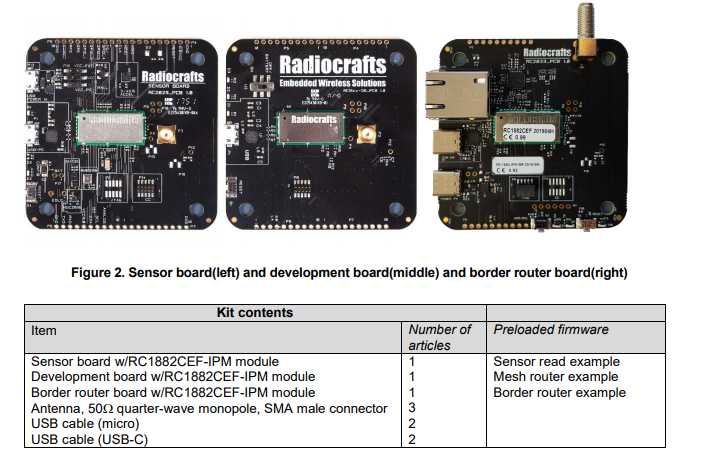
The Development Kits come in 3 versions:
- RC1882-RIIM-DK, for regular power networks (868/915 MHz)
- RC1882HP-RIIM-DK, for high power 868 MHz networks
- RC1892HP-RIIM-DK, for high power 915 MHz networks
SOFTWARE TOOLS AND REFERENCE DESIGNS
File type: |
File name: |
File description: |
|---|---|---|
RIIM SDK, the software development kit to build custom applications on IPM modules. |
||
RIIM SDK, the software development kit to build custom applications on IPM modules. |
||
This is the second revision of the Sensor Board. Schematic and PCB documentation used for our development kits. This board is recommended to use as a reference design. |
||
Schematic and PCB documentation used for the development board. This board is recommended to use as a reference design. |
||
Schematic and PCB documentation used for our development kits. This board is recommended to use as a reference design. |
DEVELOPMENT KIT AND SOFTWARE TOOLS DOCUMENTATION
File type: |
File name: |
File description: |
|---|---|---|
This is a web-based (Online) Document Library for RIIM, Radiocrafts’ Industrial IP Mesh solution. In this web-based document library you can find an introduction to RIIM, User Manuals, Quick Start Guides, benefits and features of RIIM, technical information on RIIM, an FAQ for RIIM, and much more. |
||
This User Manual describes how to use the Development Kit for RIIM modules. |
||
RIIM Quick start guide to help the reader through installation and setup of the RIIM SDK and through the process of compiling and downloading a pre-made application in the SDK. |
||
This User Manual shows you how to use the RIIM™ software development kit with application frameworks and tools for creating and uploading end applications to the RC1882CEF-IPM and RC18x2HPCF-IPM modules. |
||
This document describes various application examples you can actualize using the RIIM SDK. |

For any module inquiries please contact our local partner.
Or buy online at Digikey.com
Product Name | Frequency | Region/Compliance | Buy Module Online | Buy Development Kit Online |
RC1882CEF-IPM | 868/915 MHz | EU/US | ||
RC1882HPCF-IPM | 868 MHz | EU | ||
RC1892HPCF-IPM | 915 MHz | US |





